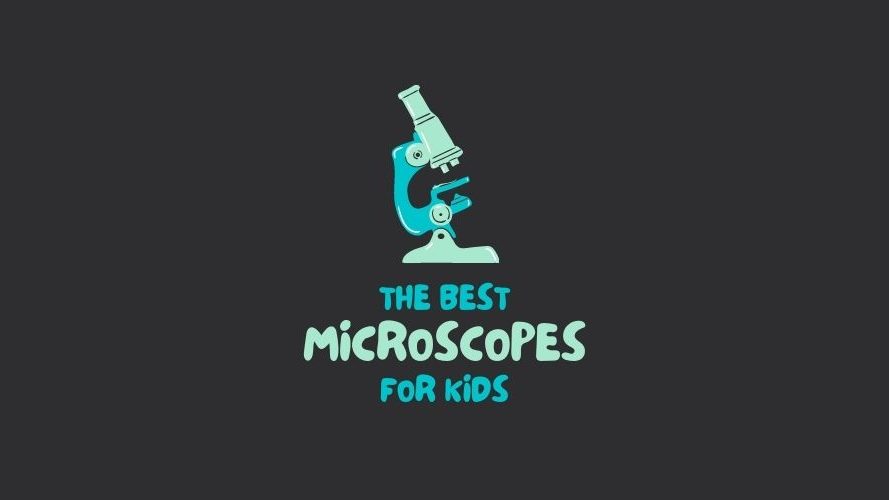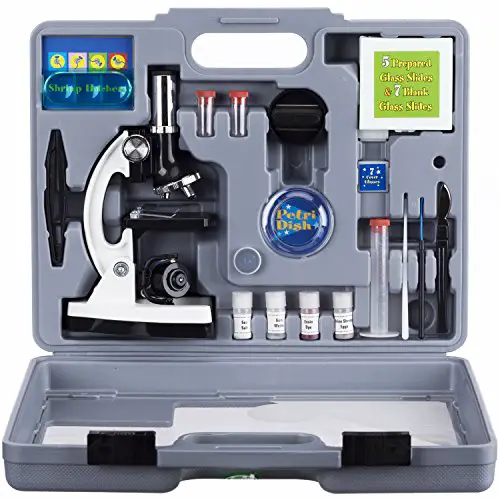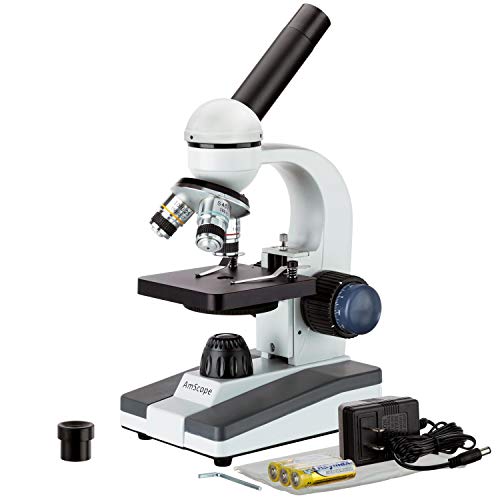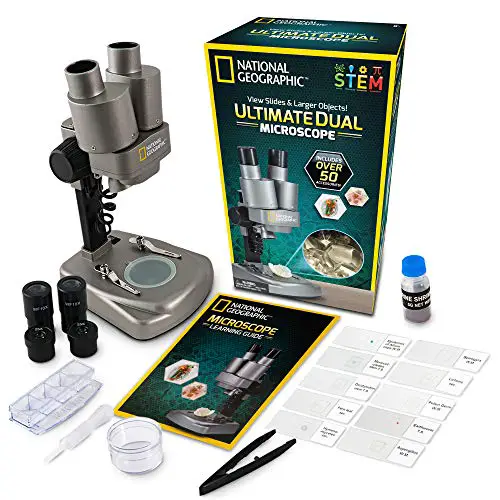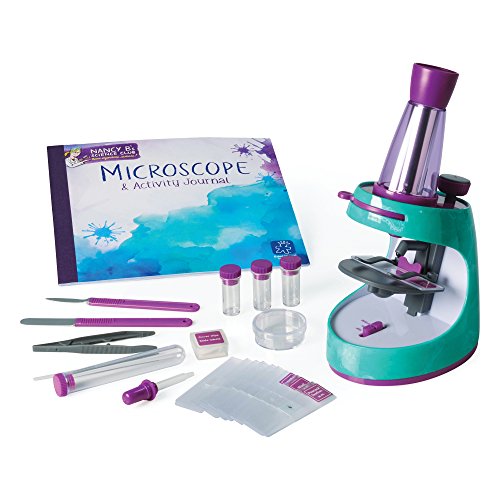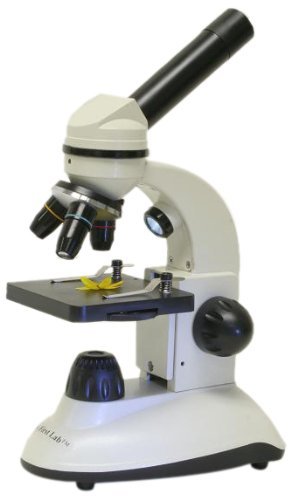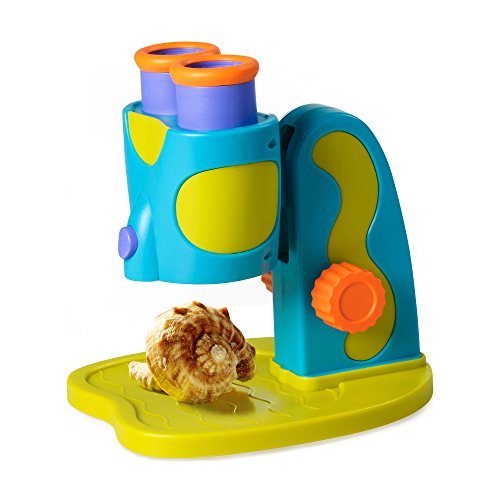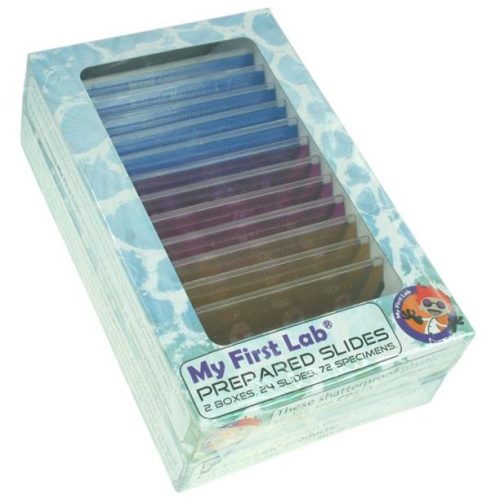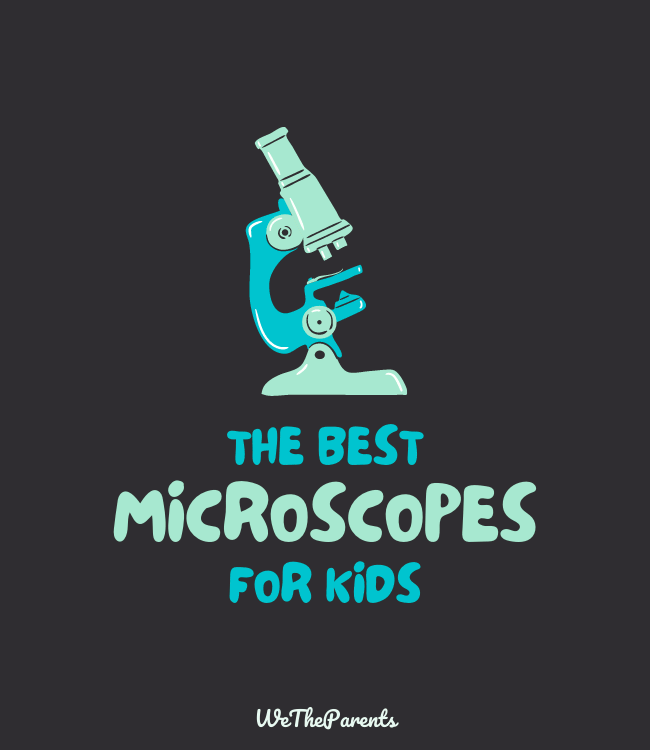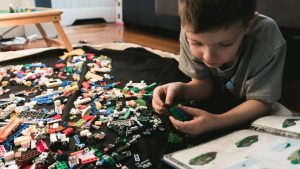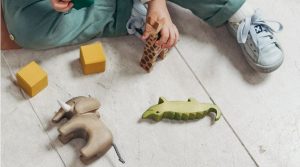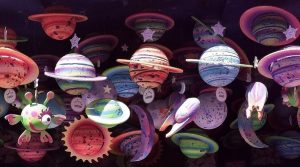Children are naturally curious, creative, and imaginative, which makes them the perfect candidates for easy-to-use scientific tools like microscopes.
A quality microscope will let them take a closer look at specimens taken from the world around them, though each set can vary in terms of content and actual scientific veracity.
A good buy requires careful shopping to ensure the device is suited to your child’s age and ability.
Let’s dive straight in and explore our carefully curated list of best-selling, top-rated, award-winning microscopes for kids.
Microscopes for toddlers through teens (reviewed in detail)
There are many types of microscopes, which can make it hard to figure out which is the best microscope for kids. Luckily, you’ll find that we’ve taken care of all the legwork, with in-depth reviews of some of the best products available, as well as a guide to help you make the right decision.
Best beginner microscope
Our opinion
The Amscope M30 (check price on Amazon) is the number one best-selling microscope for kids, and for good reason.
Put simply, it’s an outstanding beginners’ compound microscope with a super cool carry-case, making it easy for kids to store in their bedroom or use in field experiments.
The pre-teen years are a great time to introduce tools and hobbies that can blossom into serious interests and passions.
This kit has just about everything your pre-teen needs to keep them busy and challenged while they learn.
It comes in a sleek, durable case that’s both appealing to kids and protects the gear within.
The Amscope M30 features multiple magnification settings, a wide array of accessories, and an easy-to-use design.
What we love
- The magnification-power with this microscope is pretty impressive — kids can use 6 various magnification levels varying from 20x - 1,200x.
- Included with this affordable set are more than 50 accessories to help kids connect with their inner scientist. Accessories include prepared and blank slides, a spare bulb, specimen collectors, a petri dish, and even a shrimp hatchery.
- AMSCOPE’s microscope has a ton of added features for kids, like a color filter wheel that makes it easy to view certain objects, an easy-to-use focus knob, and a durable metal arm for added strength.
Watch for
- Unlike others on the list, this microscope only uses 1 LED bulb (with included spare) and a mirror for magnification purposes, which may make it harder for kids to view solid objects.
- Though the set is recommended for beginners, kids using a microscope for the first time may need assistance.
Upgrade choice
Our opinion
A little more sophisticated than some microscopes aimed at kids, the AmScope LED Student Biological Microscope (check price on Amazon) is ideal for their personal science experiments. It’s also classroom quality, so can be used for schoolwork as well.
A 360-degree swiveling head, LED illumination, and five powerful levels of magnification let them examine their specimens carefully without missing any important details, and the plain black stage has firmly fastened clips and a stain-resistant surface.
3 AA batteries, or access to an AC outlet, are required to operate the LED lights on this microscope.
What we love
- The 360-degree rotating monocular head lets kids easily share the microscope without disturbing the base or specimen
- Built-in illumination means they can shine a little light on the subject and catch every detail
- It’s a sophisticated microscope that can be used in the classroom or at home for science work
Watch for
- There's light from below but not above, so illumination isn’t as thorough as with other microscopes
- Slides can be moved up or down, but not right or left
- No slides or slips are included with this microscope, as it's a stand-alone pick
Best affordable microscope for kids
Our opinion
The National Geographic Dual LED Microscope (check price on Amazon) is a simple, yet powerful, STEM instrument that’s surprisingly inexpensive.
As you might expect from a company that so appreciates scientific veracity, the quality of this binocular microscope is of the highest standard.
It comes with a detailed handbook to guide young scientists through the basics of microscopy, as well as two sets of magnifying lenses, allowing young explorers to view specimens at either 20x or 50x magnification.
Ten prepared slides plus a selection of blank slides, covers, and tweezers provide kids with all the tools they need to explore specimens they’ll recognize and create new ones of their own.
Also included is a fun brine shrimp experiment that’s basic enough to be completed easily and is sure to thrill younger users and first-timers.
What we love
- This is a very affordable microscope
- Its dual functionality allows users to view backlit slides or top-lit 3D objects
- National Geographic provides a 2-year manufacturer’s warranty and a 100% satisfaction guarantee
Watch for
- Some parents complain that the backlight (LED) is too bright. The workaround seems to be to place either tissue paper or wax paper underneath the glass slide to diffuse the light.
- You’ll need to supply two of your own AA batteries to get the light working.
Best microscope for 4 to 8 year-olds
Our opinion
The Nancy B Science Club (check price on Amazon) is a microscope that science-minded kids love for a great reason.
These science-themed tools and toys are designed for safe (and fun) use by both young ones and those still learning.
This beginner’s microscope may look colorful and kid-friendly, but don’t be fooled.
It’s also a serious piece of equipment, and features 30x, 100x, and 400x magnification.
It also comes with an excellent activity journal and tools for setting up a host of activities and experiments.
It’s a great introduction to science for ever-growing, independent kids, and a safe, simple design makes this pick good for younger users.
What we love
- This set doesn’t simply include a microscope. Along with the tool comes an activity journal for hands-on experiments and more than 20 accessories, like slides, test tubes, and a petri dish.
- The style of the entire set is geared for younger kids. The colors are bold and the microscope includes playful designs around the exterior. Even the organization and illustrations shown in the activity journal are inviting and easy-to-use.
- There's an included, soft, rubber eye-cup that lets kids comfortably see slides at 30x, 100x, and 400x magnification.
Watch for
- This microscope’s bright teal and purple appearance may not be every young kid’s wildest dream. Though many boys will probably love the color, be aware that this microscope could be more appealing to young girls.
Best microscope for teens
Our opinion
A great choice for older kids, the Duo-Scope by My First Lab (check price on Amazon) is simple enough for first-timers but sophisticated and powerful enough to keep advanced junior scientists busy.
It’s packed with 50 accessories as well as handy features like LED illumination, while its set of included tools helps them create their own slides for examination.
Kids can take a look at specimens on prepared slides or peer directly at plants, insects, jewelry, coins, and more with a 10x to 400x magnification eyepiece.
What we love
- This microscope functions as two different tools because of the included, dual-light sources. These two lights let the microscope magnify not only slides, but 3D, solid objects as well.
- Includes a variety of accessories including 5 blank slides, 4 prepared slides, 1 well slide, forceps, test tube, petri dish, and 2 bottles of stain.
- The 10x eyepiece can provide your child with 40x, 100x, or 400x magnification.
- Dual-focusing knobs make adjusting the view simple.
Watch for
- Although the recommended age of this microscope is 9 years and above, you may find that the set is too advanced, and includes too many accessories for anyone under the age of 13.
- The microscope is battery-powered, and the dual-light sources could burn through battery-power fairly quickly.
Best 1st. microscope for toddlers
Our opinion
The GeoSafari Jr. Microscope (check price on Amazon) is designed with bright blue, yellow, and orange accents.
Visually appealing and pint-sized, it’s also durable while remaining simple and comfortable for kids to use.
It’s recommended for kids three years and older, uses 3 AAA batteries, is easy to understand, and comes with all the features your toddler will need.
What we love
- Since the microscope is meant for much younger children, it has 2 extra-large eye-pieces to make viewing objects easy and comfortable. There is also a giant, focusing knob that makes using the microscope incredibly simple.
- The compartment in which you place the objects for viewing is flat and extremely large, so just about any flat or 3D object can be placed in the viewing-area.
- The GeoSafari Jr. is great for beginners, simple to use and ultra-durable.
Watch for
- The microscope is simplified because of its intended user’s age, so it only has 1 magnification level (8x).
- If you’re looking to get the most for your money, this cute set comes without any additional accessories (though your toddler may not need them).
Best prepared microscope slides for kids
Our opinion
A microscope does your child no good if they don’t have things to look at, so this prepared slide set will keep them busy for hours!
Although it coincides with the ‘My First Lab’ microscope you saw earlier in the list, these slides can be used on virtually any type of microscope.
The slides are safe, color-coded, and organized perfectly, providing 72 specimens to examine.
Parents will love that this set is shatterproof, so there’s no risk of breakage or injury while kids are using these slides.
What we love
- There are 24 slides in each set, and a total of 72 specimens available to view.
- The specimens included on the slides cover a wide array of subject-matter, from plant, animal, and household specimens.
- My First Lab made these slides with shatter-proof glass, so you never have to worry about your kid’s safety while they're experimenting.
Watch for
- While the slides are designed to be generic, some may not fit smaller microscopes or they may be harder to view with some microscope lighting-systems.
What to look for in a kid’s microscope
Microscopes can vary in size, style, type, and function. Some features and styles may be more beneficial to children than others. The following factors should be considered before purchasing a microscope:
- Build/frame: The sturdier the product, the longer it will last. Products made of metal or heavy-duty plastics will last longer and outlast your child’s no-so-gentle touch. Microscopes made of high-quality materials are also more economical in the long-run.
- Focus and magnification: The purpose of a microscope is to view objects that cannot be seen with the naked eye, so the product’s focus and magnification specs are extremely important (source). For younger children, you may not need to provide a microscope with extremely-high magnification power. For older children, higher magnification is more useful.
- Illumination: You can’t view any slide or specimen on a microscope without a light source. These light sources can be halogen, LED, or fluorescent. LED lights are a popular choice because of their brightness and long-lasting capabilities. It’s also important to consider how many lights a microscope uses, and if it comes with replacement bulbs. Replacement bulbs for some products may be hard to find.
- Accessories and features: Each microscope will come with its own features and accessories. Younger children will require less of these options, while older ones can really make use of them. Pay attention to what’s included with the product, like slides, specimen storage, tools, and instruction/activity books. Look for features that make using the microscope easier, like two eye-pieces instead of one (binocular vs. monocular), mechanical viewing areas, adjustability, and color-focus.
Getting started: A kids guide to using a microscope
The first step to using a microscope is understanding what it’s used for and what it can do. A microscope is, essentially, a very large magnifying glass that allows for the viewing of specimens that cannot be seen with the naked eye. The invention of microscopes has made possible the advance of knowledge in almost every area of the scientific, medical, and technological world.
But what are the differences between various microscopes? While there may be variations in each individual product, there are two main types of microscopes, which fall into the following categories:
- Low-power microscopes: These are also called “stereo” microscopes, and are used to view opaque objects (like coins, rocks, etc.), with the lighting source splitting into two separate paths to give you a 3D view.
- High-power microscopes: These are called “compound” microscopes and are used to view translucent samples (like cells, bacteria, etc.), with only one lighting source, providing you with a flat-plane view.
No matter which type of microscope you choose for your child, many general functions are the same. Make sure that your child uses the microscope on a flat, sturdy surface.
Learn how to turn on and adjust the light source to allow different levels of light to enter. Turning the focus knobs one way or another helps hone in on the specimen, while the nosepiece can be rotated for magnification changes.
Each type of microscope will have its own set of instructions. Before use, ensure your child understands how to use the microscope properly. Fortunately, most come with manuals on how to use each function properly. For step-by-step directions on how to get started, let’s begin here (source).
Fun microscope experiments for kids
Kids can use a microscope in a variety of ways. After learning how to use slides, your child can view various fibers, foods, hair, and more.
Here are a few experiments or ideas to get your kid started on their microscope adventure:
- Spider web experiment: Naturally, a child should never go looking for spiders by themselves and parents should always be aware of indigenous species that may be harmful. That said, this experiment is pretty cool. You’ll only need a sample of spider web, a glass slide, and some clear nail polish. First, place a bit of nail polish on the slide and let it dry for about 1 minute (don’t let it try completely). Next, place the slide against a part of the web to capture it. Remove any extra web and place the cover on top of the slide. Your kid will be amazed at how the web looks under magnification.
- Onion experiment: This experiment is quite common because onions are easy to come by. All you need for this experiment is an onion, tweezers, a slide, and a liquid. You can use water or methylene blue (to see color) for making this wet slide. The onion should be cut (by an adult). After cutting, remove a piece of the clear membrane in between the onion layers. Place the membrane on the slide, add your liquid and cover it. Onions are surprisingly interesting to look at but remember, they can make you and your kids cry!
- Money experiment: If youve some cash or coins on you, your kid can try this experiment. You need no slide or equipment other than the money and the microscope. Coins and dollar bills can work, and if you’re feeling generous, let them look at one of your more-expensive bills. All your child needs to do for this experiment is place the money directly on the viewing platform and ensure that the diaphragm is open to its maximum setting, to allow for maximum light-flow. Moving the coins and bills around lets kids get a closer look at how money is made, what it is made of, and all of the awesome colors and patterns that make it so complex.
Here are some great experiment ideas for beginners.
Our top pick is…
If you’re looking for the best bang for your buck, the Amscope M30 (check price on Amazon) is our sure-fire winner. It can be used by a wide range of age groups, comes with a ton of accessories and ideas, and is budget-friendly. It is durable enough to be used for years and years and comes with all the necessary components for a good science experiment.


